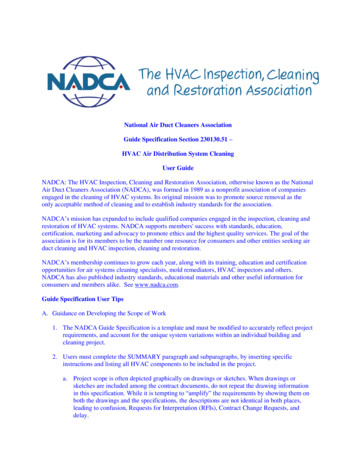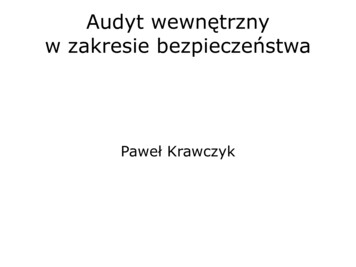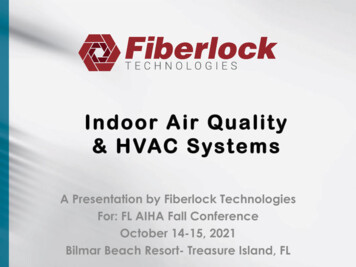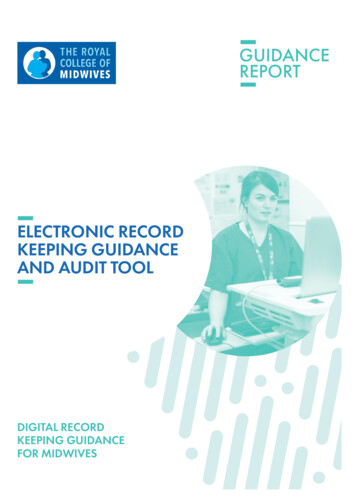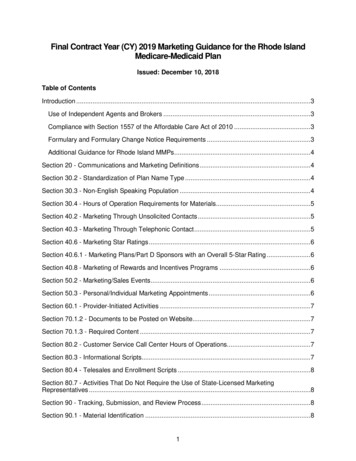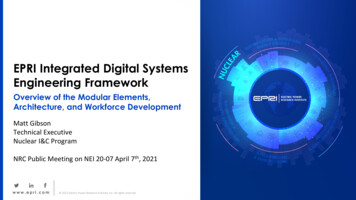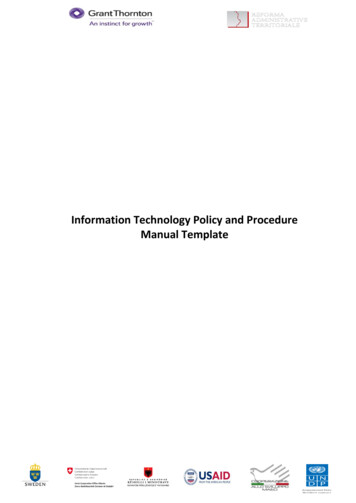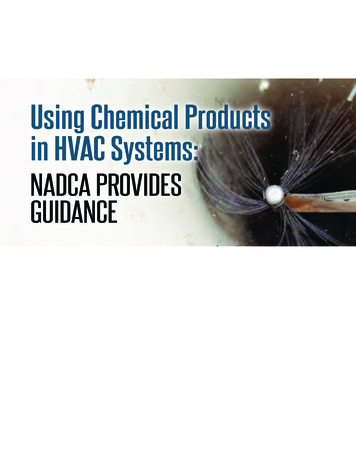
Transcription
Using Chemical Productsin HVAC Systems:NADCA PROVIDESGUIDANCE
NADCA POSITION PAPERon Chemical ProductApplications in HVAC SystemsContributors:Mike White, Chairman, Education Committee, Dan Stradford, Chairman, Chemical Position Paper Task ForceBob Baker, John Bently, David Governo, Dan Greenblatt, Tim Hoysradt, Richard Lantz, Tracy Lantz, Joe MacDonald, Larry Robertson, Cole StantonIntroductionAwareness of indoor air quality has increasedsubstantially in recent years, and the systems that supplyair to our living and working spaces are critical to themaintenance of a healthy indoor environment. As theglobal industry’s leading advocate and trusted resourcefor reliable information, The National Air DuctCleaners Association (NADCA) is uniquely qualifiedto provide guidance for consumers and the industry onthe best practices for inspecting, cleaning and restoringHVAC systems.One topic that has generated both substantial interestand concern is the use of chemicals, cleaners, sealantsand coatings inside air handling systems. Currently abroad diversity of information exists regarding the useand efficacy of these chemical products. In workingwith all parties associated with indoor air quality,NADCA recognizes the need to provide direction in thiscomplicated and evolving area.It is generally agreed that source removal ofcontaminants remains the single best method forcleaning and decontaminating HVAC systems. However,chemicals may be applied within HVAC systems fora variety of reasons. This position paper provides anoverview of the products and associated techniquesutilized in and around HVAC systems.NADCA’s goal is to provide sound guidance forall parties (consumers, regulators, and remediationprofessionals) that can be useful when evaluatingspecific structures and situations. Although thefollowing information reflects the current state of theart for the use of chemicals in HVAC systems, readersshould recognize that new developments regularly occurand should familiarize themselves with the most currentinformation when determining the appropriate steps totake. Readers are encouraged to review NADCA’s ACRStandard for Assessment, Cleaning & Restoration ofHVAC Systems, for information regarding best practicesrelated to cleaning and restoring those systems.DisclaimerNADCA recognizes that differences in opinion willexist as to how to manage the use of chemical products.NADCA also recognizes that industry professionalswill decide whether or not a chemical applicationis appropriate for a given HVAC system, based onthe unique circumstances surrounding that system.Ultimately, the decision of whether or not to apply achemical product in an HVAC system, and the selectionof that product, rests with the owner of the system.This document was written in the United States ofAmerica and is intended primarily for use in thiscountry. This material may also prove useful forindustry professionals and others operating outside ofthe USA. All users of this document are encouraged torefer to applicable federal, state/provincial, and/or localauthorities having jurisdiction over the subjects addressedwithin this document.HVAC ContaminationNumerous types of contamination may be found withinHVAC systems. Depending on the environment andconditions, these contaminants may contribute to mold/mildew (i.e., fungal growth) and other microbiologicalgrowth. Other contaminants may include debris fromoutside air sources, fire damage residue, dust, vermin, etc.Source RemovalSource removal is defined as the physical removal ofcontaminants and debris from internal HVAC systemsurfaces. Complete HVAC system cleaning removesthe contaminants that may contribute to mold andother microbiological growth. Cleaning can also reducehousehold dust, increase energy efficiency, increaseequipment life expectancy, and improve overall indoorair quality and comfort.It is not necessary to apply chemical products to achievesource removal within an HVAC system. However,applying appropriate cleaning compounds may enhancethe cleaning process (e.g., coils, hard surfaces, blowers).
Safety Considerations & MSDSA variety of safety considerations must be taken intoaccount as part of any chemical application within anHVAC system.A Material Safety Data Sheet (MSDS) is a documentproduced by a chemical product manufacturer thatcontains information on the chemical makeup, use,storage, handling, emergency procedures and potentialhealth effects related to a chemical product. The MSDSmay contain more information about the material thanthe label on the container.In the United States, the Occupational Safety andHealth Administration (OSHA) requires that the MSDSbe available at any job site where chemical productsare in use. When concentrated products are used at thework site, manufacturers may make available a dilutedsolution MSDS (referred to as a “use solution”), as wellas secondary-use labels for the application container forsuch diluted solutions. All application containers musthave use labels affixed to them.Other nations may have different regulations regardingthe use of the MSDS, bulletin or materials and chemicalproducts so this should be taken into considerationwhen delivering service outside the United States.Some people are sensitive to certain chemical products.If there is a reason to believe that the use of a productwould create a hazard, information about the potentialhazard must be communicated to the buildingoccupants and/or managers. In some circumstances,it may be necessary to perform work when occupantsare out of the building and to adequately ventilate thebuilding. With certain EPA-registered products, buildingevacuation is mandatory.Workers must be trained to follow procedures on thelabel and in the current MSDS bulletin for the safeuse, handling, and storage of any product used to treatan HVAC system. Appropriate personal protectiveequipment must be worn, including respiratoryprotection if required. Correct application proceduresmust be understood and carried out to avoid hazardsfrom failing to use the product according to themanufacturer’s instructions.Risk ManagementPossible risks associated with chemical products include,but are not limited to:Allergic reactionsChemical burnsn Respiratory irritation or damagen Eye injuriesn Poisoningn Toxic fumesn Exposure to carcinogensnnIt is recommended that the client sign a releaseauthorizing the use of specific chemical products andacknowledging that he or she has been informed of risksassociated with their use.Products that are used to mitigate pests are requiredto be registered with the EPA. When using an EPAregistered product, a state pesticide applicator’s licensemay be required for the owner, firm, supervisor and/or worker. All users of this document are encouraged torefer to applicable federal, state/provincial, and/or localauthorities having jurisdiction over the subject addressedwithin this document.Categories of Chemical ProductsA variety of chemical products may be used as part of anHVAC system cleaning process.Note: In general, chemical products that do not makea claim of antimicrobial activity are not required to beregistered with the Environmental Protection Agency(EPA). Some exceptions exist.Antimicrobial Pesticides(including disinfectants and sanitizers)Product definitionAntimicrobial pesticide: Any substance or mixture ofsubstances intended to prevent, destroy, repel or mitigatea microbial pest. These agents kill or suppress the growthof microorganisms (bacteria, viruses and fungi). In theabsence of product claims, if the product is composed ofingredients known to be pesticides and they do not havea non-pesticidal use, then the product is a pesticide. If theproduct’s mode of action is pesticidal in nature (no nonpesticidal use) then the product is a pesticide. If the intentis to distribute or sell the pesticide, it must be registeredby the EPA as well as with the state in which it will besold or used.Sanitizer: The term “sanitizer” is often misused andmisunderstood. A sanitizer is a substance or mixture ofsubstances that kills a high percentage (99.9%) of, butnot necessarily all, bacteria on a surface. Technically,the EPA defines a sanitizer as a substance or mixtureof substances that reduces the bacterial population inthe inanimate environment (on surfaces and objects) bysignificant numbers (e.g, 3 log10 reduction or more), butdoes not destroy or eliminate all bacteria.1 Anotheruseful definition is: an agent that reduces contaminationin the inanimate environment to levels considered safe asdetermined by public health ordinance.2Disinfectant: An agent that eliminates a specific speciesof infectious or other undesired microorganism, but notnecessarily bacterial spores, in the inanimate environmentonly.2 Disinfectant products are often found to beeffective against fungi and viruses as well as bacteria.
Fungicide: A substance that destroys fungi and yeastand/or fungal spores (on environmental surfaces) thatmay pose a threat to human health.Fungistat: An agent that inhibits the growth offungi of economic or aesthetic significance thatare not considered to be human health related (onenvironmental surfaces). This agent has no fungicidalclaim.Bacteriostat: An agent similar to a fungistat in thatit inhibits the growth of bacteria (on environmentalsurfaces) that is not considered to be human healthrelated.Algaestats: An agent similar to a fungistat in that itinhibits the growth of algae that is not considered to behuman health related.nProducts chosen must include label directionsdetailing use in HVAC systems and theircomponents and those directions must be followed.Application methodProducts are generally applied through spraying,wiping or fogging. However, the application methodchosen must be one that is in the label directions.Antimicrobials should only be applied after the surfaceshave been cleaned. Surface soil or contamination caninterfere with the efficacy of a product. Antimicrobialproducts are evaluated based on use pattern (locationsof use) and application method for potential humanexposure and risk. When using any antimicrobialproduct, follow the directions carefully and use thepersonal protective equipment as directed by the label.At this time, the EPA has not accepted any disinfectant,sanitizer or fungicidal products for use in the ductworkof HVAC systems. However, some of these products areaccepted for use in other parts of HVAC systems.ProsThose products which have been accepted by the EPAfor use in the ductwork of HVAC systems include thefollowing claims:ConsFungistaticBacteriostaticInhibits odor-causing bacteria and fungiInhibits stain and damage-causing bacteria,fungi, and algaen Deodorizesn Inhibits fungi and algaen Cleaning (a non pesticidal activity; removalof contaminants)nnnnAntimicrobial products are available for the treatmentof coils, drain pans and other related HVAC systemsurfaces. Refer to the EPA-accepted product label forspecific directions for treatment of these surfaces.Typical usenThe major use of antimicrobial products in HVACsystems is for the inhibition of microbial growthon hard surfaces within components such as airhandlers, fans and duct interiors.nDisinfectant products may be used in coils, drainpans, and other parts of the air handler.nHVAC components that have been exposed toflood water or sewage contamination should beassumed to contain disease-causing organisms andshould be disinfected prior to being placed backinto service. Since no disinfectants are registeredfor use in air ducts, systems that have been exposedto contamination from floods, sewage, or similarbiological contamination must be evaluated bya qualified individual prior to being placed backinto service. Cleaning alone may or may not besatisfactory. Replacement of such duct sections maybe necessary.Properly used, antimicrobials can help reduce the risk orincidence of future microbial growth.Overuse of antimicrobial products can lead to needlessexposure to chemicals.Failure to follow label directions can pose risks or resultin ineffective product performance.In some applications it can be difficult to apply theproduct in a manner that ensures adequate coverage anddwell time, leading to ineffective product performance.EPA requirementsAll antimicrobial pesticides for use in HVAC systems arerequired to be registered by the EPA. Products withoutspecific HVAC directions are not to be used on thesesurfaces. A product has only been evaluated based onthe directions for use listed on the label. The product islikely not to be effective if used in incorrect amounts orfor a different dwell time.Every pesticide label bears the following misusestatement: “It is a violation of Federal law to use aproduct in a manner inconsistent with its labeling.”It means that if the product is used in a manner otherthan that which is directed by the label, such action maybe illegal and put the applicator and occupants of thebuilding at risk.The label will also include the following information:nSpecific pest(s) against which the product is effective(meaning that the product has only passed thetesting requirements for those organisms listed onthe label).nSites (homes, hospitals, etc.) and surfaces (e.g.,cooling coil) to which the product may be applied.This means that the product may only be usedat those sites and on those surfaces which areidentified on the label.
nType of equipment or method used to apply theproduct including application rate and contact time.nDuring the application or cure, sealants may giveoff irritating fumes.nHow often the product is applied. Reapply asdirected by the label.nOccupants may need to leave the building duringapplication or while the sealant cures.nIn order for the product to be effective it mustbe used in accordance with the directions for use(application method and rate, and dwell time).nSystem may need to remain shut down for a periodof time to allow sealant to cure.nPesticide manufacturers may make available adiluted-solution or secondary-container-use label(which must be consistent with the EPA-approvedlabel) when using concentrated products.Best PracticesEPA requirementsMost sealants do not make claims of antimicrobialactivity, so they do not have to be registered with theEPA.Best practicesIt is prudent to perform a duct leakage test to determinethe condition of the ductwork and establish whetherduct sealing would be beneficial.nFollow instructions and safety precautions as perthe EPA-accepted label.nUse in a well-ventilated area.nKeep in original or properly marked container.Once the need has been established, the appropriatematerials and methods can be chosen.nLabel all containers. Where concentrated productsare used, label containers holding diluted (ready-touse) products.Correct protective equipment should be used byemployees applying sealants.Ensure occupants are not exposed to objectionable fumelevels during application and drying.SealantsProduct definitionSealants are materials – liquids of varying viscosity ortapes - used to seal surfaces, joints, connections, gapsand openings.Resurfacing MaterialsProduct definitionTypical useResurfacing materials (also known as repair coatings)are coatings that are applied to surfaces that show signsof damage or degradation.Sealants are used in HVAC systems to control airleakage.Typical useApplication methodA sealant may be applied like paint with a brush, roller,trowel, or spray equipment. It also may come in a caulktube and be applied with a caulk gun. Sealants can existas tape as well.ProsnImproves energy efficiency of an HVAC system.nImproves performance of an HVAC system.nReduces air leakage, as well as air intake fromunconditioned areas.nSome sealants have elastomeric (flexible) propertiesto maintain integrity of seal.ConsnDifficult to apply after systems have beenconstructed.nIf the material used is not applied properly or doesnot have the proper characteristics, it may crack,split or separate from the surface it is applied to,allowing air leakage.Resurfacing materials may be used to coat internallylined or fiberglass ductwork to provide a smoothersurface and control odors in the system. This reducesresistance of airflow in the system. Coatings secure loosefibers to reduce the potential that they will becomeairborne and enter the conditioned space. Resurfacingmaterials may also be used to protect duct surfacesfrom moisture and conditions that may lead to rust andcorrosion. Some coatings have antimicrobial ingredientssolely to preserve the coating and help retard the growthof mold and fungi on the coating film.In no case should a coating be used in lieu of sourceremoval cleaning of an HVAC system. Refer to theNADCA Standard, Assessment, Cleaning & Restorationof HVAC Systems.Application methodResurfacing materials are usually applied like paint witha brush, roller or spray equipment.ProsnCan restore integrity to a duct system.nRetards or repairs fiberglass deterioration.
nSaves costly replacement of duct board or lining inductwork or air handler.nCoatings can isolate non-removable particulatefrom the airstream.nCoatings can smooth the interior profile of surfaceswithin HVAC systems to make them easier to cleanin the future.nCoatings can yield a smooth film surface whendry that reduces the probability of depositionand accumulation of foreign materials that couldsupport future microbial activity.nEnsure occupants are not exposed to potentiallyhazardous fume levels during application anddrying time.nUsers must comply with EPA, state and localregulations. Building codes and/or engineeringspecifications may require that coatings havebeen tested to certain ASTM test methods (suchas ASTM E 84 and ASTM C 411) as required bythe performance protocols of the National FireProtection Association (NFPA) 90A/90B. (ASTMInternational is an organization that establishes testmethods, among other things.) Before using anyresurfacing coating, copies of this testing should beobtained from the product manufacturer.ConsnDoes not replace duct cleaningnAdds an additional stage to an HVAC project afterinitial duct cleaning which will create additionalexpense.nOccupants may need to leave the building whilecoatings are applied or curing.nMay affect sound attenuation where lining orfiberboard are used for that purpose.nSome odors may linger after application.nUsing EPA-registered coatings (with antimicrobialproperties) requires some form of licensing in somestates which may add additional costs and burdensto the applicator.nSystem may need to remain shut down for a periodof time to allow sealant to cure.EPA requirementsSome coatings may contain antimicrobial ingredientsto preserve the integrity of the product, but if theproduct does not make antimicrobial claims, EPAregistration is not required. Coatings and sealantsused as resurfacing and repair products that do notclaim to kill microorganisms, and which claim only toprevent growth on or in the coating film, do not needto be registered by the EPA for use in ductwork. Suchproducts fall within the scope of the Treated ArticlesExemption of the Federal Insecticide, Fungicide andRodenticide Act (FIFRA). The EPA does not intend toregister or regulate resurfacing coatings that do notmake pesticidal claims.Coil Cleaning CompoundsProduct DefinitionCoil Cleaners are a subset of a broad category thatincludes all hard-surface cleaning agents. These cleaningcompounds differ from general-purpose consumerproducts in that the soil that accumulates on surfaces ofrefrigeration and air-conditioning coils tends to be moreresistant to removal than soil on walls, floors, countertops and bathroom fixtures. In addition, coil structure(especially aluminum fins) can be more easily damagedthan most environmental surfaces. For example, driedlayers of organic debris on an evaporator coil can bealmost as difficult to remove as baked-on oven soil,however, while a thin aluminum fin is easily damaged,the porcelain or stainless steel surface of an oven ishighly resistant to damage.There are three general formulation strategies thatmanufacturers follow in manufacturing coil cleaners:nAcid: These products combine an acid (phosphoric,hydrofluoric, etc.) with a detergent. They generallyhave a pH of 3 or below. They work by creating achemical reaction with the aluminum of the coil finsthat mechanically helps release the soil that is thenheld in suspension by the detergent until it is rinsedoff.nAlkaline: These cleaners are formulated bycombining sodium hydroxide, potassium hydroxideor some other caustic with a surfactant (soap). Theynormally have a pH of 10 or above and work inmuch the same way as acid cleaners by creating achemical reaction that mechanically breaks soil free.nDetergent: These are more complex formulations.They combine different detergents and otheringredients to create a strong cleaner. There is awide variety of these formulations and they varygreatly in effectiveness against the types of soil thatare found in coils. Detergent cleaners are sometimescalled ‘neutral’ cleaners. This is an error as aBest practicesnDuctwork, components, and surfaces to be coatedshould be thoroughly cleaned and evaluated beforecoating for best results.nMaterials must be used in accordance withmanufacturer’s instructions and in accordance withthe label.nCorrect protective equipment should be used byemployees applying resurfacing materials.
formulation would have to be exactly pH 7 to betruly neutral and detergent cleaners generally fall ina range between pH 4 and 9.Important Note: Sometimes, cleaners are formulated forspecific types of soils. For example, systems that servecommercial kitchens may have greasy soil that requiresa special formulation. In addition, regional conditionsmay favor one cleaning formulation over another. It isnormal for contractors to select coil cleaners by trial,eventually settling on one or two formulations thatwork best for the conditions that they encounter. Userand occupant safety is a critical issue and cleaners atboth ends of the pH range tend to be unpleasant to useand handle.have enough power to penetrate, yet not enoughto damage or bend the fins. Spraying directlyfacing the fins rather than across fins will result inless damage. Cleaner should be sprayed from sideto side onto the coil assembly, starting from thebottom and working to the top. This allows loosesoil to rinse out of the coil assembly as you proceedrather than falling down the fins and becomingmore impacted.nTypical useTraditionally, acid cleaners are used on condensercoils because the types of soils that are associated withtheir outside location are more easily removed by theacid formulation. In a like manner, alkaline cleanerssometimes work better with the greasy soil that isoften found on indoor evaporator, chilled water, orheat pump coils. Because both of these cleaner typescan be unpleasant to use and can damage coil surfaces,there has been a trend toward greater use of detergentcleaners. Acid cleaners should never be used indoors asthey release unpleasant and potentially dangerous fumesunless rinsed completely from all surfaces in the airhandler.Coil cleaners are normally used for cleaning otherportions of an HVAC system such as fans and housings,drain pans, supply and return grills and supply plenumsthat have an accumulation of soil and microbial growth.In special situations such as following a fire, an entireduct system may have to be cleaned with a detergentcleaner.ProsnThe soil that accumulates on coils (especiallycooling coils) is extremely difficult to remove.Unless a coil is cleaned very frequently, it is virtuallyimpossible to remove the soil without using somecleaning compound.nCleaners speed up soil removal and thus less laboris needed for coil cleaning.nMore complete cleaning results in significant energysavings.nComplete cleaning lowers the possibility of bacteriaand fungi growing on coil surfaces being carried tooccupied spaces.ConsnUse of a cleaner risks exposure to chemicals thatmay be toxic or irritating to users and occupants.nSome areas have regulations preventing thedischarge of cleaning compounds (especiallyalkaline cleaners) into storm sewers or roof drains.nSome cleaners (extremely high and low pH) candamage and shorten the life of the coils.Application methodEach manufacturer develops directions for the use ofits cleaners, and in many cases these directions arebased on actual research findings. For this reason, auser should always refer to the directions printed onthe container label as the best way to effectively use theproduct. The following are generally applicable to allcoil-cleaning compounds:nPrepare the proper use dilution: The productlabel should recommend a starting-use dilution.A common dilution is one part cleaner to threeparts water. In most cases water from the tap isacceptable.nApply to coil: Dilute cleaner can be applied with ahand sprayer or a power sprayer. In most situations,a power sprayer – not to exceed 150 psi - providesbetter coverage and deeper penetration into thedepth of the fin assembly. Several sprayers aremanufactured specifically for coil cleaning andAllow soaking time: The soil-removal activity ofmost cleaners takes time so the cleaner should notbe rinsed off too soon. Four to five minutes is agood general soak time. However, do not let thecleaner dry on the coil surface or it may be difficultto rinse off. Some coil cleaners are marketed as ‘norinse’ as the condensate is supposed to wash theresidue off. If a coil is cleaned during a dry time ofyear, that does not happen since there is little or nocondensate.EPA RequirementsThe EPA does not have the authority to regulatecleaning compounds. However, in the spring of 2010,the EPA published a notice that they had receivedreports of cleaners that are being marketed with claimsthat they “remove microbial growth.” If marketersmake such claims, those products will be regulated asantimicrobial pesticide products. Thus, it is importantthat service providers and sellers of coil-cleaningcompounds not make any claims related to microbialgrowth control, prevention, or removal as this wouldmake their product subject to registration by the EPA.
Best PracticesProsSelect the product that represents the best balancebetween effectiveness, potential for least equipmentdamage, and lowest risk to users and occupants ofspaces served by the equipment being cleaned.nSimple to use.nEasily available.nInexpensive.nFollow printed label directions.nEffective for mild to moderate cleaning jobs.nFor EPA-registered pesticides, use in compliancewith the EPA-accepted label.nUse the smallest quantity of cleaner that will do thejob.nInform the customer that you will be using a coilcleaning compound and provide him or her accessto the label and MSDS.EPA requirementsnRinse thoroughly with clean water even if a “norinse” cleaner is used.Soaps and detergents are generally not required to beregistered by the EPA unless pesticidal claims are made.nClean frequently enough that there is not a majorbuildup of soil.Best practicesnPerform multiple cleanings if needed to completelyremove soil.nOften coils can be more completely cleaned if theyare removed and taken to a location outside orwhere plenty of water is available for thoroughrinsing.nSoaps and DetergentsConsnMay contain perfumes that occupants could findobjectionable.nNot effective or only partially effective for heavyduty cleaning tasks.nFollow the manufacturer’s application instructions,including any safety recommendations.nIf product is scented, ensure occupants do notobject to using it.nDo not wet fiberglass or electrical components inHVAC systems.nAvoid damage that may be caused by dripping andleaking while cleaning.nEnsure any wet walking surfaces are taped off toavoid slips and falls.Product definitionSoaps and detergents are technically known assurfactants, a word that comes from “surface” and“active.” Soaps and detergents are substances that,when added to water, cause the water to dissolvecompounds more easily. They do so by changing theproperties of the water’s surface.Typical useSoaps and detergents are used in general cleaningsituations where heavy-duty or specialty cleaners arenot required. Uses include washing register grills andwiping down surfaces. They may also be included inthe ingredients of more specialized products such as coilcleaners and heavy-duty degreasers.DegreasersProduct definitionA chemical product that dissolves fat-based andother water-insoluble substances. Degreasers varyin ingredients from simple surfactants (see above) topowerful caustics that can react with other chemicals.Typical useCleaning grease or oils from a hard surface. In HVACsystems, a degreaser may be required if the systemhas been exposed to cooking fumes or fat-basedcontaminants.Application methodApplication methodSoaps and detergents are simple to use. They arenormally added to water in the amount desired, andthe mixture is applied to the item being cleaned witha cloth, brush, or other scrubbing method. Check themanufacturer’s instructions for recommended productto-water ratios and other application recommendations.“Cold cleaning” is generally referred to as cleaningbelow the boiling point of water or at roomtemperature. There are three general methods of coldcleaning - wipe or cloth, spraying, and dipping.ProsnVery effective.nInexpensive.
nEasy to use.nNo special equipment required.ProsConsnEasy to apply.nReduces or eliminates odors.nMust be kept in original or marked container.nPotential allergic reactions for users and occupants.nMay mask but not remove odor.nSome degreasers may be harmful to skin or ifinhaled.nBuilding occupants may have objections to the useof chemicals or scents in the product.nPossible chemical sensitivity for users andoccupants.nnPossible offensive odor during use.nContainment of overspray.Occasionally people report asthma attacks, allergicresponse, headaches, breathing difficulties, or otherhealth problems when exposed
of HVAC systems. However, some of these products are accepted for use in . other parts. of HVAC systems. Those products which have been accepted by the EPA for use in the ductwork of HVAC systems include the following claims: n. Fungistatic . n. Bacteriostatic . n. Inhibits odor-causing bacteria and fungi . n. Inhibits stain and damage-causing .

